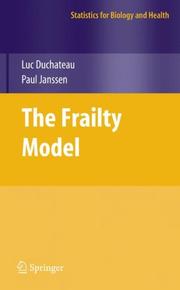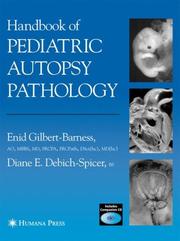| Listing 1 - 3 of 3 |
Sort by
|
Book
ISBN: 9781402086922 1402086911 9781402086915 9048179548 140208692X Year: 2008 Volume: 25 Publisher: Dordrecht : Springer Netherlands : Imprint: Springer,
Abstract | Keywords | Export | Availability | Bookmark
 Loading...
Loading...Choose an application
- Reference Manager
- EndNote
- RefWorks (Direct export to RefWorks)
Social differences in health and mortality constitute a persistent finding in epidemiological, demographic, and sociological research. This topic is increasingly discussed in the political debate and is among the most urgent public health issues. However, it is still unknown if socioeconomic mortality differences increase or decrease with age. This book provides a comprehensive, thoughtful and critical discussion of all aspects involved in the relationship between socioeconomic status, health and mortality. In a well-written language, it synthesizes the sociological theory of social inequality and an empirical study of mortality differences that has been performed at the Max Planck Institute for Demographic Research (Rostock, Germany). The best available datasets from Denmark and the USA, as two very different countries, are used to analyze the age pattern of social mortality differences, the Danish register data covering the whole Danish population between 1980 and 2002. This study is the most comprehensive analysis of socioeconomic mortality differences in the literature, in terms of data quantity, quality, and the statistical method of event-history modeling. It makes important new theoretical and empirical contributions. With a new method it also addresses the question whether the measurement of social mortality differences in old age so far has been biased by mortality selection due to unobserved heterogeneity. "This book signifies an important step forward in theory, empirical data analysis and methodology and an advancement for many disciplines involved in the subject of socioeconomic differences in old age mortality". Prof. Dr. Gabriele Doblhammer, Max Planck Institute for Demographic Research, Rostock, Germany.
epidemiologie --- geriatrie --- sociale economie --- sociologie --- demografie --- Demography --- Geriatrics --- Sociology --- Economic sociology --- Epidemiology --- Older people --- Mortality --- Personnes âgées --- Mortalité --- Mortality. --- Social conditions. --- Economic conditions. --- Social aspects. --- Economic aspects. --- Conditions sociales --- Conditions économiques --- Aspect social --- Aspect économique --- EPUB-LIV-FT LIVHUMAI SPRINGER-B --- Demography. --- Population. --- Epidemiology. --- Geriatrics. --- Population Economics. --- Sociology of Family, Youth and Aging. --- Sociology, general. --- Geriatrics/Gerontology. --- Medicine --- Gerontology --- Diseases --- Public health --- Human population --- Human populations --- Population growth --- Populations, Human --- Economics --- Human ecology --- Malthusianism --- Historical demography --- Social sciences --- Population --- Vital statistics --- Health and hygiene --- Social groups. --- Family. --- Sociology. --- Social theory --- Family --- Families --- Family life --- Family relationships --- Family structure --- Relationships, Family --- Structure, Family --- Social institutions --- Birth order --- Domestic relations --- Home --- Households --- Kinship --- Marriage --- Matriarchy --- Parenthood --- Patriarchy --- Association --- Group dynamics --- Groups, Social --- Associations, institutions, etc. --- Social participation --- Social aspects --- Social conditions

ISBN: 9780387728346 0387728341 9786611107949 1281107948 038772835X 9780387728353 Year: 2008 Publisher: New York : Springer Verlag,
Abstract | Keywords | Export | Availability | Bookmark
 Loading...
Loading...Choose an application
- Reference Manager
- EndNote
- RefWorks (Direct export to RefWorks)
Clustered survival data are encountered in many scientific disciplines including human and veterinary medicine, biology, epidemiology, public health and demography. Frailty models provide a powerful tool to analyse clustered survival data. In contrast to the large number of research publications on frailty models, relatively few statistical software packages contain frailty models. It is demanding for statistical practitioners and graduate students to grasp a good knowledge on frailty models from the existing literature. This book provides an in-depth discussion and explanation of the basics of frailty model methodology for such readers. The discussion includes parametric and semiparametric frailty models and accelerated failure time models. Common techniques to fit frailty models include the EM-algorithm, penalised likelihood techniques, Laplacian integration and Bayesian techniques. More advanced frailty models for hierarchical data are also included. Real-life examples are used to demonstrate how particular frailty models can be fitted and how the results should be interpreted. The programs to fit all the worked-out examples in the book are available from the Springer website with most of the programs developed in the freeware packages R and Winbugs. The book starts with a brief overview of some basic concepts in classical survival analysis, collecting what is needed for the reading on the more complex frailty models. Luc Duchateau is Associate Professor of Statistics at the Faculty of Veterinary Medicine of the Ghent University, Belgium. He is board member of the Quetelet Society (Belgian Region of the International Biometric Society) and of the International Biometric Society Channel Network. He has collaborated extensively with physicians in oncology and allergy, public health workers and veterinarians, and is an author of numerous papers in statistical, medical and veterinarian journals. Paul Janssen is Professor of Statistics at the Centre for Statistics of the Hasselt University, Diepenbeek, Belgium. He is an elected member of the International Statistical Institute. He spent research visits at the Johns Hopkins University (Baltimore, USA) and the University of Washington (Seattle, USA). His research interests include survival analysis, nonparametric estimation, resampling techniques and asymptotic theory.
epidemiologie --- biostatistiek --- Biomathematics. Biometry. Biostatistics --- vormgeving --- besmettelijke ziekten --- Oncology. Neoplasms --- biomathematica --- simulaties --- Artificial intelligence. Robotics. Simulation. Graphics --- oncologie --- Infectious diseases. Communicable diseases --- biometrie --- medische statistiek --- Epidemiology --- Mathematical statistics --- Survival Analysis --- Statistics --- Statistique --- EPUB-LIV-FT LIVSTATI SPRINGER-B --- Statistics. --- 57.087.1 --- 616-036.8 --- Statistical analysis --- Statistical data --- Statistical methods --- Statistical science --- Mathematics --- Econometrics --- 57.087.1 Biometry. Statistical study and treatment of biological data --- Biometry. Statistical study and treatment of biological data --- 616-036.8 Final stage. Termination. Consequences. Results. Successes. Setbacks. Failures. Efficacy. Inefficacy. Survival. Statistics. Mortality in a specific disease --- Final stage. Termination. Consequences. Results. Successes. Setbacks. Failures. Efficacy. Inefficacy. Survival. Statistics. Mortality in a specific disease --- Distribution (Probability theory. --- Oncology. --- Computer simulation. --- Biometry. --- Emerging infectious diseases. --- Probability Theory and Stochastic Processes. --- Statistics for Life Sciences, Medicine, Health Sciences. --- Cancer Research. --- Simulation and Modeling. --- Biometrics. --- Infectious Diseases. --- Emerging infections --- New infectious diseases --- Re-emerging infectious diseases --- Reemerging infectious diseases --- Communicable diseases --- Computer modeling --- Computer models --- Modeling, Computer --- Models, Computer --- Simulation, Computer --- Electromechanical analogies --- Mathematical models --- Simulation methods --- Model-integrated computing --- Tumors --- Distribution functions --- Frequency distribution --- Characteristic functions --- Probabilities --- Biological statistics --- Biology --- Biometrics (Biology) --- Biostatistics --- Biomathematics --- Probabilities. --- Statistics . --- Cancer research. --- Biometrics (Biology). --- Infectious diseases. --- Cancer research --- Probability --- Statistical inference --- Combinations --- Chance --- Least squares --- Risk

ISBN: 9781592596737 158829224X 9781588292247 9786610360604 1280360607 1592596738 Year: 2005 Publisher: Totowa, N.J. : [Oxford : Humana ; Blackwell, distributor],
Abstract | Keywords | Export | Availability | Bookmark
 Loading...
Loading...Choose an application
- Reference Manager
- EndNote
- RefWorks (Direct export to RefWorks)
Pathologists have long recognized that the pediatric autopsy requires great care in technique and dissection to ensure that easily overlooked malformations are recognized and accurate diagnoses are made. Working in the tradition of the master pediatric pathologists, the highly experienced practitioners Enid Gilbert-Barness, MD, and Diane E. Debich-Spicer have created in the Handbook of Pediatric Autopsy Pathology a comprehensive reference guide to the successful performance of pediatric autopsies and the optimal recognition and interpretation of their pathologic findings. The authors cover such major developmental disorders as hydrops, chromosomal defects, congenital abnormalities, and metabolic disorders. The reviews of the organ systems encompass the cardiovascular, respiratory, gastrointestinal, renal, central nervous, and skeletal systems, plus the male and female genitourinary systems, the eye and adnexa, and the thymus, spleen, lymph nodes, and immunodeficiency. Additional chapters address sudden infant death, cytogenetics, the medical and forensic autopsy, special procedures, cultures and infection control, and biological hazards at the autopsy. Numerous standard reference tables, copious illustrations and drawings, and an appendix at the end of each chapter provide a wealth of practical information and bibliographic citations. A value-added compact disk provides color versions of over 400 selected illustrations found in the book. Cutting-edge and detailed, the Handbook of Pediatric Autopsy Pathology offers the prosector unequaled guidance to performing a pediatric autopsy, making an accurate diagnosis, and-where malformations are involved-explaining the implications of possible recurrences in future pregnancies.
Medicine & Public Health. --- Pathology. --- Medicine. --- Médecine --- Pathologie --- Autopsy -- Handbooks, manuals, etc. --- Fetal death -- Handbooks, manuals, etc. --- Pediatric pathology -- Handbooks, manuals, etc. --- Perinatal death -- Handbooks, manuals, etc. --- Pediatric pathology --- Autopsy --- Fetal death --- Perinatal death --- Pregnancy Complications --- Infant --- Medicine --- Investigative Techniques --- Publication Formats --- Death --- Forensic Medicine --- Age Groups --- Pathologic Processes --- Persons --- Female Urogenital Diseases and Pregnancy Complications --- Analytical, Diagnostic and Therapeutic Techniques and Equipment --- Forensic Sciences --- Publication Characteristics --- Health Occupations --- Disciplines and Occupations --- Pathological Conditions, Signs and Symptoms --- Diseases --- Named Groups --- Criminology --- Social Sciences --- Anthropology, Education, Sociology and Social Phenomena --- Pathology --- Handbooks --- Fetal Death --- Infant, Newborn --- Methods --- Child --- Health & Biological Sciences --- Pediatrics --- Death, Perinatal --- Loss, Perinatal --- Perinatal loss --- Perinatal mortality --- Fetal stillbirth --- Fetal wastage --- Fetus --- Fetus, Death of the --- Intrauterine death --- Reproductive wastage --- Wastage, Fetal --- Necropsy --- Necroscopy --- Post-mortem examinations --- Postmortem examinations --- Postmortems --- Pregnancy --- Anatomy, Pathological --- Dead bodies (Law) --- Human dissection --- Medical jurisprudence --- Complications --- Causes
| Listing 1 - 3 of 3 |
Sort by
|

 Search
Search Feedback
Feedback About
About Help
Help News
News